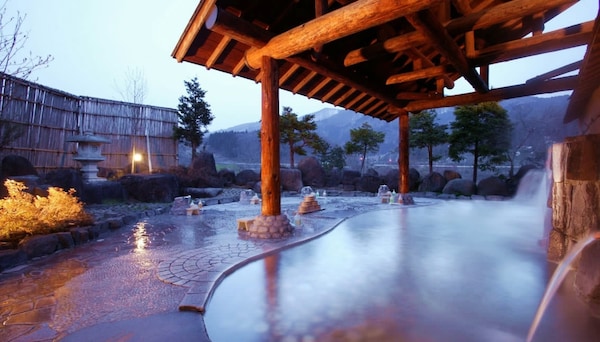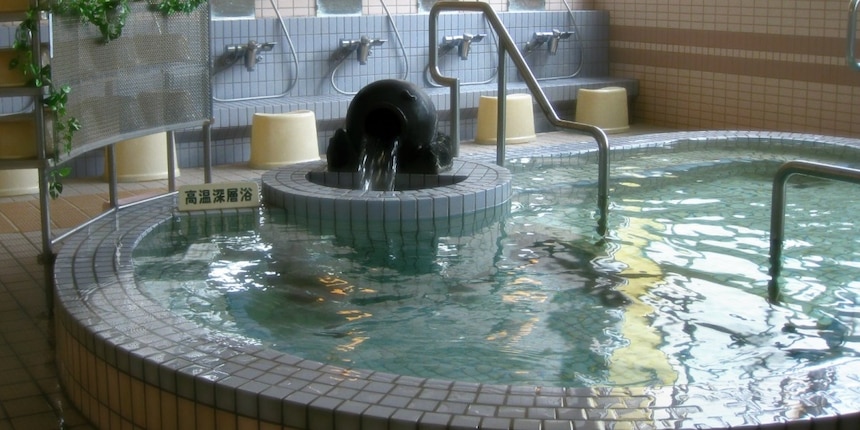A Guide to Onsen Water Types
All water isn’t the same. Every natural spring passes through layers upon layers of rock that can give the water a unique chemical makeup said to have a variety of health effects depending on the mineral content of the water. As a result, many onsen use their water type as a central marketing tool. It can be good to know what they're talking about!
Simple Thermal Springs

https://doyouknowjapan.com/onsen/
Simple thermal springs (tanjun onsen) with less than 1,000 ppm mineral composition don’t offer any special benefits based on their chemical constituents. However, the heat of any onsen water is said to stimulate your metabolism, the pressure massages your muscles and the buoyancy helps you relax by relieving your body of the burden of gravity.
Saline Springs
http://opt.jtb.co.jp/kokunai_opt/p/p1021131/
All saline onsen types are said to help in the healing of cuts, burns and chronic skin disorders.
Alkaline sodium bicarbonate springs (tansan suiso ensen) have the additional property of making the skin smooth.
Sulfate and chloride springs come in three types: sodium, calcium and magnesium. Briny chloride springs (enka butsusen) are supposed to improve a weak constitution and chronic gynecological disorders, and will also keep you warm as the salt on your skin prevents your sweat from evaporating.
Meanwhile, soaking in any sulfate spring (ryusan sen) is said to help with arteriosclerosis, while a calcium sulfate spring has added effects against rheumatism, and sodium sulfate helps with high blood pressure.
On the minus side, chloride and sodium bicarbonate springs are not advised for people with kidney problems, high blood pressure, thyroiditis or swelling in any part of their bodies. Sulfate springs, on the other hand, are supposedly bad for people with diarrhea—which is presumably not so good for anyone else in the water as well.
Special Springs
http://www.kirikoku.co.jp/onsen-somurie/6938/
Found mainly in highland areas, acidic springs (sansei sen) are said to have an antibacterial effect and help with chronic dermatitis. People with sensitive skin should be wary of overexposure, however, and you should be sure to pour fresh water on your body after bathing.
A carbon dioxide spring (nisanka-tanso ensen) has at least 100 milligrams of carbonic acid per kilogram of spring water, resulting in a fine froth on the surface. While relatively rare in Japan, these springs are said to help with cuts, burns, arteriosclerosis and hypertension, as well as lowering blood pressure as your blood vessels expand.
Sulfur springs (io sen) will smell like bad eggs, and are said to expand the blood vessels and help with cuts, arteriosclerosis, hypertension, chronic dermatitis, chronic gynecological disorders and gout. The sulfur is also said to be good for acne and spots as it can soften any hardened keratin on the surface of the skin.
http://www.jalan.net/onsen/OSN_50350.html
Ferruginous springs (gantetsu sen) with high iron content are supposed to help with menstrual disorders, anemia and rheumatism. They’re distinguished by their red-brown sediment, created when the iron oxidizes as it comes into contact with the air.
Radioactive springs (hosha-no-sen) contain small amounts of radioactive minerals, and are sometimes referred to as radon or radium springs. The radiation is absorbed by the skin and respiratory organs, but is supposed to leave your body immediately after bathing. These springs are said to be effective against the gamut of hypertension, arteriosclerosis, chronic dermatitis and chronic gynecological disorders.
We hope this will help you choose the right onsen for you—and understand the hype the next time someone tries to get you excited about the local water type!




